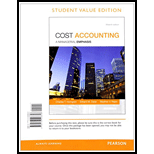
1.
To compute: The equivalent units of transferred in costs, direct material and conversion costs for June 2014.
Given information:
Beginning: Degree of completion: transferred in costs 100%, direct material 0%; conversion costs; 50%.
Ending: Degree of completion: transferred in costs 100%, direct material 0%; conversion costs; 75%.
Total cost added during June is $27,000.
Beginning transferred in cost is $60,000.
Total transferred in cost added during June is $117,000.
Beginning cost of conversion is $24,000.
Total conversion cost added during June is $62,400.
2.
To compute: The cost assign to equivalent units of transferred in costs direct material and conversion costs.
3.
To compute: The cost assign to units completed and units in ending work in process.
Want to see the full answer?
Check out a sample textbook solution
Chapter 17 Solutions
Cost Accounting, Student Value Edition Plus MyAccountingLab with Pearson eText -- Access Card Package (15th Edition)
- On January 1, 20X2, Maxwell, which uses the straight-line method, purchases a machine for $81,000 that it expects to last for 10 years; Maxwell expects the machine to have a residual value of $12,000. What is the machine's book value at the end of 20X4? i. $54,000 ii. $47,250 iii. $60,300 iv. $57,600arrow_forwardExpert of general accounting answerarrow_forwardPlease explain the solution to this General accounting problem with accurate principles.arrow_forward
- I need help finding the correct solution to this financial accounting problem with valid methods.arrow_forwardI need help with this general accounting problem using proper accounting guidelines.arrow_forwardCan you help me solve this general accounting problem with the correct methodology?arrow_forward

 AccountingAccountingISBN:9781337272094Author:WARREN, Carl S., Reeve, James M., Duchac, Jonathan E.Publisher:Cengage Learning,
AccountingAccountingISBN:9781337272094Author:WARREN, Carl S., Reeve, James M., Duchac, Jonathan E.Publisher:Cengage Learning, Accounting Information SystemsAccountingISBN:9781337619202Author:Hall, James A.Publisher:Cengage Learning,
Accounting Information SystemsAccountingISBN:9781337619202Author:Hall, James A.Publisher:Cengage Learning, Horngren's Cost Accounting: A Managerial Emphasis...AccountingISBN:9780134475585Author:Srikant M. Datar, Madhav V. RajanPublisher:PEARSON
Horngren's Cost Accounting: A Managerial Emphasis...AccountingISBN:9780134475585Author:Srikant M. Datar, Madhav V. RajanPublisher:PEARSON Intermediate AccountingAccountingISBN:9781259722660Author:J. David Spiceland, Mark W. Nelson, Wayne M ThomasPublisher:McGraw-Hill Education
Intermediate AccountingAccountingISBN:9781259722660Author:J. David Spiceland, Mark W. Nelson, Wayne M ThomasPublisher:McGraw-Hill Education Financial and Managerial AccountingAccountingISBN:9781259726705Author:John J Wild, Ken W. Shaw, Barbara Chiappetta Fundamental Accounting PrinciplesPublisher:McGraw-Hill Education
Financial and Managerial AccountingAccountingISBN:9781259726705Author:John J Wild, Ken W. Shaw, Barbara Chiappetta Fundamental Accounting PrinciplesPublisher:McGraw-Hill Education





